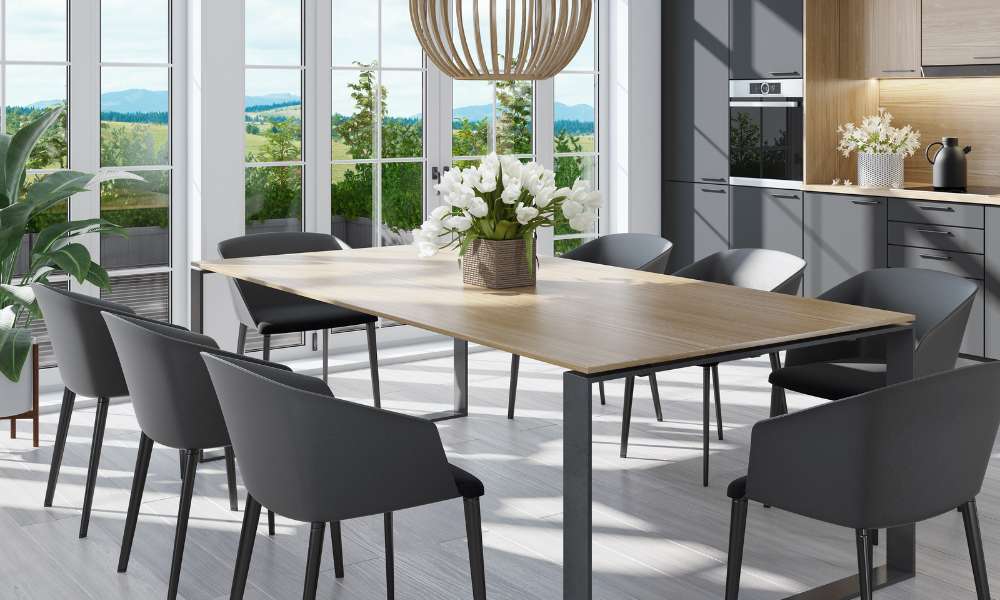Creating the perfect dining space involves more than just choosing a beautiful table and matching chairs. One crucial aspect that often gets overlooked is ensuring there is adequate space around the dining table. Proper spacing not only enhances the room’s aesthetic appeal but also ensures comfort and functionality for everyone seated. Whether you’re hosting a large dinner party or enjoying a quiet family meal, the right amount of space around your dining table allows for easy movement, comfortable seating, and an overall enjoyable dining experience.
In this article, we will provide comprehensive guidelines on how much space is needed around a dining table. We will explore standard spacing recommendations, consider various factors that influence space requirements, and offer practical tips for maximizing your dining area.
1. Understanding the Basics:
Definition of Dining Table Space
Dining table space refers to the area surrounding the dining table that allows for comfortable movement and seating. This space is crucial for ensuring that diners can easily sit down, stand up, and move around the table without feeling cramped. Adequate spacing around the table not only contributes to a pleasant dining experience but also enhances the overall functionality of the dining room. By considering the space needed for movement and comfort, you can create an eating area that is both practical and inviting.
Standard Dining Table Sizes
Dining tables come in various sizes, typically designed to seat a specific number of people. Common eating table sizes include 4-seater, 6-seater, and 8-seater tables. A 4-seater table is usually around 48 inches long, a 6-seater table is approximately 60 to 72 inches long, and an 8-seater table can range from 72 to 96 inches long. The size of the dining table directly impacts the amount of space required around it. For example, a larger table that seats more people will need more surrounding space to accommodate additional chairs and ensure everyone has enough room to move comfortably. Understanding these standard sizes helps in planning the layout and ensuring that the dining area remains functional and aesthetically pleasing.
2. Recommended Spacing Guidelines:
Minimum Clearance
When arranging your dining space, it’s essential to provide a minimum clearance around the table to ensure comfort and ease of movement. The recommended minimum clearance is 36 inches on all sides of the table. This measurement allows enough space for diners to pull out chairs and sit down comfortably without bumping into walls or other furniture. The 36-inch clearance also facilitates easy passage behind seated guests, making it easier to navigate the eating area, serve food, and accommodate additional diners if necessary.
Optimal Clearance
For maximum comfort and a more spacious feel, an optimal clearance of 42-48 inches around the dining table is ideal. This additional space provides even more room for movement, allowing diners to navigate the area effortlessly and enjoy a more relaxed eating experience. Optimal spacing is particularly beneficial for larger gatherings or when hosting events, as it accommodates the increased activity and movement around the table. By ensuring an optimal clearance, you create an eating environment that is both functional and inviting, enhancing the overall dining experience for everyone.
3. Factors Influencing Space Requirements:
Room Size and Shape
The dimensions and layout of your dining room significantly impact the spacing needs around your eating table. In smaller rooms, it’s crucial to maximize space by using compact furniture and considering multipurpose pieces. For medium-sized rooms, a balanced arrangement that allows for comfortable movement without overcrowding is ideal. In larger rooms, you have more flexibility to include additional furniture pieces while still maintaining ample space around the dining table. It’s important to arrange furniture thoughtfully to ensure that the room feels neither too cramped nor too sparse, regardless of its size.
Type of Seating
The type of seating you choose for your dining area also affects space requirements. Armchairs, for instance, take up more room than armless chairs due to their wider dimensions. When planning your eating area, consider using armless chairs to save space or benches, which can be pushed under the table when not in use, freeing up more room. Additionally, you can mix and match different seating types to create a versatile and functional dining setup that caters to your space constraints and aesthetic preferences.
Traffic Flow
Ensuring smooth traffic flow is essential for a functional eating area. Proper spacing around the dining desk allows for clear pathways, making it easy for diners to move around the room without obstruction. Strategically positioning the table and chairs, keeping pathways at least 36 inches wide, and avoiding placing furniture directly in high-traffic areas can help maintain accessibility. By accounting for traffic flow, you can create an eating space that is both practical and comfortable, enhancing the overall dining experience for you and your
4. Practical Tips for Maximizing Space:
Flexible Furniture Arrangements
Incorporating flexible furniture arrangements can significantly enhance the functionality of your dining area, especially in smaller spaces. Consider using extendable tables that can be adjusted to accommodate more guests when needed and folded back to save space when not in use. Folding chairs are another practical solution, as they can be easily stored away when not required. Multifunctional furniture, such as benches with storage compartments or sideboards that double as serving stations, can provide additional utility without overcrowding the room. These flexible arrangements allow you to adapt your eating space to various needs and occasions, making it more versatile and efficient.
Design Solutions
Utilizing design techniques can create the illusion of a more spacious dining area. Mirrors strategically placed on walls can reflect light and open up the space, making it feel larger. Adequate lighting is essential; a well-lit room appears more open and inviting. Choosing light colors for walls and furniture can also enhance the sense of the area, as lighter shades tend to make a room feel more airy and expansive. Additionally, smart storage solutions, such as built-in cabinets, floating shelves, or under-table storage, help keep the eating area organized and clutter-free. By employing these design strategies, you can maximize the space in your eating room, making it both functional and aesthetically
5. Case Studies and Examples:
Real-Life Examples
Examining real-life examples of dining room setups with varying spaces around the tables can provide valuable insights. For instance, a compact apartment eating area with a 4-seater table might utilize armless chairs and a minimalistic design to maximize the area. In contrast, a spacious dining room in a suburban home could feature an 8-seater table with generous 48-inch clearance, allowing for a grander arrangement with larger chairs and decorative elements. By analyzing these examples, we can see how different approaches to spacing and furniture selection contribute to a comfortable and functional dining environment. What works well in each setup often depends on balancing space efficiency with aesthetic appeal, ensuring that the eating area meets the household’s practical and stylistic needs.
Expert Opinions
Insights from interior designers highlight best practices for dining table spacing. Many professionals emphasize the importance of maintaining at least 36 inches of clearance around the table to ensure easy movement and access. Renowned designer Jane Smith suggests, “In smaller spaces, opt for round tables as they provide better flow and flexibility.” Additionally, designer John Doe recommends, “Incorporate multifunctional furniture to save space without sacrificing style.” These expert tips underscore the importance of thoughtful planning and the use of versatile furnishings to create a well-designed eating area that is both practical and visually appealing.
Conclusion
Creating a functional and aesthetically pleasing dining space involves more than just selecting the right table and chairs. Ensuring there is adequate area around the eating table is essential for comfort, ease of movement, and overall eating experience. By understanding the basics of eating table areas, adhering to recommended spacing guidelines, and considering factors such as room size, seating types, and traffic flow, you can design a dining area that meets your needs. Implementing practical tips like flexible furniture arrangements and smart design solutions can help maximize the available space, making even small eating areas feel open and inviting. Real-life examples and expert opinions further illustrate how thoughtful planning and design can enhance the functionality and appeal of your eating space.





